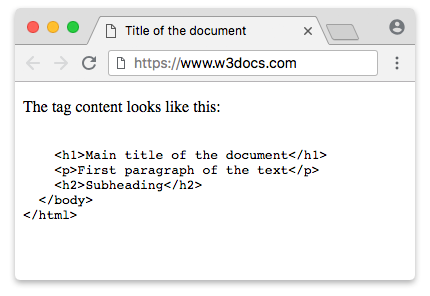The <plaintext> tag tells the browser, that its content must be displayed as an ordinary text without formatting. All the nested tags in this element are rendered by the browser as a part of the text. The content of the <plaintext> tag is represented in monospaced font. The monospaced font can be applied to any HTML element using the CSS font-family style with the "monospace" generic value.
The <plaintext> is a deprecated HTML tag, instead of it use the <pre> tag, or the <code> tag, if semantically accurate.
In the case, where <plaintext> is the first element on the page, using HTML is not preferable. Instead, you can serve a text file with the text/plain MIME-type.
Syntax
The <plaintext> tag is empty, which means that the closing tag isn’t required.
Example of the HTML <plaintext> property:
<!DOCTYPE html>
<html>
<head>
<title>Title of the document</title>
</head>
<body>
<p>The tag content looks like this:</p>
<plaintext>
<h1>Main title of the document</h1>
<p>First paragraph of the text</p>
<h2>Subheading</h2>
</body>
</html>Result

Attributes
The <plaintext> tag supports the Global Attributes.
Browser support
|
|
|
|
|
|---|---|---|---|
| ✓ | 4+ | ✓ | ✓ |
Practice Your Knowledge
What is the function of the <plaintext> tag in HTML?
Correct!
Incorrect!
Quiz Time: Test Your Skills!
Ready to challenge what you've learned? Dive into our interactive quizzes for a deeper understanding and a fun way to reinforce your knowledge.